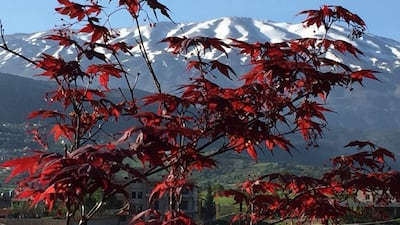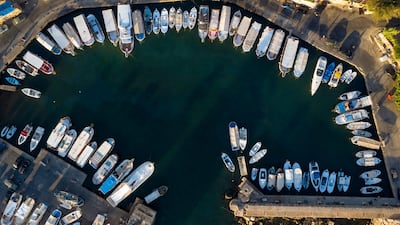With its diverse museums and unmissable restaurants, picturesque coastline and forested mountainsides, ancient heritage sites and glittering ski slopes, Lebanon has plenty to offer visitors all year round. Since a travel warning in 2011 turned into an outright ban in February 2016, citizens of the UAE have been unable to enjoy the country's many draws, but the lifting of the travel ban this week means that Lebanon is poised to regain its status as one of the region's most exciting and diverse holiday destinations.
Since the travel ban was implemented, Lebanon has added several new strings to its bow, particularly with regard to its cultural scene. Add to that its many ancient treasures, stunning natural sites and bountiful opportunities for entertainment and it promises to offer something for everyone. First time visitors can situate themselves with a tour of Beirut courtesy of City Sightseeing's new hop-on hop-off double decker buses, introduced to the capital this summer, while returning visitors will find plenty of new spots to add to their list of favourites.
Here are our top ten things to do:
Art attack
For culture and history lovers, the Sursock Museum is a must-see. Located in Beirut's historic Achrafieh, the museum re-opened in the autumn of 2015, after a seven-year closure and renovations costing more than $10 million (Dh36.7 million). Located in a stunning mansion dating from 1912, the museum houses a permanent collection of works by prominent Lebanese modern and contemporary artists. Temporary exhibitions are hosted on the ground floor and a new basement exhibition hall hollowed out below the historic courtyard. These often have a regional focus, but the museum is showing a collection of original works by Pablo Picasso until the end of the year.

Museum Mile
Beit Beirut, Lebanon's first museum of memory, opened to the public in the summer of 2017. The museum runs an irregular programme of temporary exhibitions dealing with the city's past, present and future. Housed in a beautiful open-fronted mansion dating from 1924, it was a notorious snipers' nest during the Lebanese civil war and was left a burnt-out shell. An $18 million restoration has transformed it into an exhibition space that retains the traces of damage left by years of violence. The new "Museum Mile" leads from Beit Beirut to the National Museum of Beirut. Don't miss the Mim Mineral Museum, located midway between the two – its stunning collection is one of the best in the world.
A trip for the taste buds
Since founding the first branch of Tawlet in 2009, Kamal Mouzawak has expanded his culinary empire across the country, serving up authentic, locally grown, homemade Lebanese cuisine. His original location in Mar Mikhael offers a unique array of Lebanese mezze, salads, main courses and desserts each lunch time. Each meal is prepared by a team of women from different parts of the country, who serve up their local twists on traditional Lebanese fare. Launched earlier this year, Tawlet el Hamra offers a wider range of options, serving breakfast, lunch and dinner and offering an a la carte menu, a plat du jour and a barbeque buffet on Saturdays and Sundays.







Ottoman splendour in a mountain setting
One of Lebanon’s most spectacular historic sites is Beiteddine Palace, located in the Chouf mountains, an hour's drive from Beirut. The ornate Ottoman palace was built between 1788 and 1818 by Emir Bechir Chehab II and is a masterpiece of traditional Arab architecture, with elegant stone arcades, colourful inlaid stonework and carved wooden ceilings. The nearby village of Deir al-Qamar offers picturesque cobbled streets, an old-fashioned town square and the historic Fakhreddine Mosque, which dates from 1493 and is famous for its beautiful octagonal minaret. Spend a night in keeping with the historic surroundings at the luxurious Mir Amin Palace Hotel, a miniature version of Beiteddine Palace built by the same Ottoman governor.
Souks and citadels
For a history-infused day trip from Beirut, head to Saida, a seaside city with ancient souks that are still used by locals, as well as a unique 13th Crusader sea castle and a surprisingly interesting soap museum. Keep an eye out for Debbane Palace, an Ottoman residence dating from 1721, hidden away in the narrow alleyways of the souk, and don't miss the stunning view from its rooftop. Down on the seafront, take a peek inside the historic Khan el Franj, a traditional 17th century caravanserai, and then head to the castle, a rugged seaside ruin steeped in atmosphere and history.
Fish and Phoenician ruins
The Nabu Museum, launched last year and housed in a weathered steel building designed by Iraqi artist Dia Azzawi, offers a unique combination of art and artefacts. Located 60km north of Beirut, it pairs hundreds of stunning artefacts from the Bronze, Iron, Roman, Greek, Byzantine and Islamic eras with 20th century works by Lebanese, Iraqi and Palestinian artists. Pair a trip to this museum, named for the Mesopotamian god of literacy, with an afternoon in picturesque Batroun, a nearby seaside town with restaurants serving up fresh seafood, cobbled alleyways, historic churches and the imposing remains of an ancient Phoenician seawall that dates back more than 2000 years.
Slalom in style
In winter, nothing beats a day or two spent on the ski slopes. Mzaar Kfardebian, located an hour from Beirut, is the largest ski resort in the Middle East. Spread across 42 hills, with stunning views of the surrounding mountains, it offers 80 kilometres of slopes. A private ski slope connects the main resort with the nearby InterContinental Mzaar Lebanon Mountain Resort and Spa. Another appealing option is the Cedars Ski Resort, a small, picturesque resort located further north and at higher altitudes, above the dramatic Qadisha Valley and close to the enclave of ancient trees known as the Cedars of God.
Modernist marvels
Lebanon is famous for its ancient Phoenician, Roman, Byzantine and Ottoman sites, but its modernist architectural heritage is often overlooked. One of the country's most fascinating ruins is located in Tripoli. The Rachid Karami Tripoli International Fair was designed by pioneering Brazilian modernist architect Oscar Niemeyer in the 1960s. Commissioned by the Lebanese president, Niemeyer envisioned a vast park filled with free-standing sculptural concrete buildings. The fair was one year away from completion when the civil war broke out, and it was soon occupied by militia groups. Plans to put it to use since the war ended have fallen through, resulting in a spectacular modern ruin, a series of eerie yet magical sculptures set amid a carefully maintained garden.
Urban adventures
Lebanon often lures travellers away from its capital but Beirut is a lively city with a rich history of its own. In recent years, several walking tours have sprung up, offering diverse ways to explore the capital's eclectic urban fabric. Architecture buffs will enjoy Layers of a Ghost City, which delves into the destruction and reconstruction of Downtown Beirut, while history lovers should try Walk Beirut, a four-hour Odyssey that takes in the entire history of the ancient capital, from antiquity to the modern day. For a more alternative vibe, a prominent local street artist runs Beirut Graffiti Tour, providing a unique view of Beirut and its flourishing subcultures.
Shop ’til you drop
Beirut is the heartland for shoppers, boasting everything from small local boutiques to international designer stores and Lebanese couture. Souvenirs, furnishings and clothing with a traditional Arab flavour can be found at Orient 499 in Clemenceau, while Zawal and Plan Bey offer art prints, books and handmade works by local artists and artisans. For high-end clothing and jewellery, Beirut Souks and the surrounding streets are home to international brands including Hermes, Gucci, Chanel and Dior. Lebanon is famous for its rich design scene and many up-and-coming furniture and product designers have open studios based in Saifi Village and Karantina.



